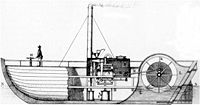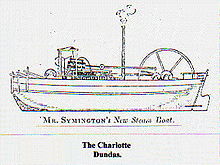
Charlotte Dundas
Encyclopedia
The Charlotte Dundas is regarded as the world's "first practical steamboat
", the first towing steamboat and the boat that demonstrated the practicality of steam power for ships.
Development of experimental steam engined paddle boats by William Symington
had halted when the sponsor, Patrick Miller of Dalswinton
, abandoned the project. Symington had continued building steam pumping engines and mill engines. In 1793 he had developed a drive using a pivoted crosshead beam above the vertical cylinder to transmit power to a crank.
Miller's project and Captain John Schank
's unsuccessful attempt at a canal steam tug had come to the attention of Thomas, Lord Dundas
, Governor of the Forth and Clyde Canal
Company, and a meeting of the canal company's directors on the 5th June 1800 approved his proposals on the basis of "a model of a boat by Captain Schank to be worked by a steam engine by Mr Symington".
 The boat was built by Alexander Hart at Grangemouth
The boat was built by Alexander Hart at Grangemouth
to Symington's design with a vertical cylinder engine and crosshead transmitting power to a crank driving the paddlewheels. Trials on the River Carron
in June 1801 were successful. This first boat may have been named the "Charlotte Dundas" and the trials apparently included towing sloop
s from the river Forth
up the Carron and thence along the Forth and Clyde Canal
. There was concern about wave damage to the canal banks, and possibly the boat was found to be underpowered on the canal, so the canal company refused further trials.
In 1801 Symington patented a horizontal steam engine directly linked to a crank, and got the support of Lord Dundas for a second steamboat which would become famous as the Charlotte Dundas, named in honour of his Lordship's daughter.
 Symington designed a new hull around his this powerful horizontal engine, with the crank driving a large paddle wheel in a central upstand in the hull, aimed at avoiding damage to the canal banks.
Symington designed a new hull around his this powerful horizontal engine, with the crank driving a large paddle wheel in a central upstand in the hull, aimed at avoiding damage to the canal banks.
The new boat was 56 ft (17.1 m) long, 18 ft (5.5 m) wide and 8 ft (2.4 m) depth, with a wooden hull.
After a model of the boat was made and shown to Lord Dundas, the boat was built by John Allan, and the engine by the Carron Company
.
The first sailing was on the canal in Glasgow
on January 4, 1803, with Lord Dundas and a few of his relatives and friends on board. After some improvements, in March 1803 the Charlotte Dundas towed two 70 ton barges 30 km (almost 20 miles) along the Forth and Clyde Canal
to Glasgow
, and despite "a strong breeze right ahead" which stopped all other canal boats it took only nine and a quarter hours, giving an average speed of about 3 km/h (2 mph). This demonstrated the practicality of steam power for towing boats.
Plans to introduce boats on the Forth and Clyde canal were thwarted, largely by fears of erosion of the banks, and a project to build tug boats for the Bridgewater Canal had ended with the Duke of Bridgewater's death a few days before the March trial. The Charlotte Dundas was left in a backwater of the canal at Bainsford until it was broken up in 1861. Symington was not paid all he had invested in construction of the Charlotte Dundas and was left disappointed, but the development of steamboat
s was continued by others including Robert Fulton
in the USA and Henry Bell in Scotland
.
See also:
Steamboat
A steamboat or steamship, sometimes called a steamer, is a ship in which the primary method of propulsion is steam power, typically driving propellers or paddlewheels...
", the first towing steamboat and the boat that demonstrated the practicality of steam power for ships.
Development of experimental steam engined paddle boats by William Symington
William Symington
William Symington was a Scottish engineer and inventor, and the builder of the first practical steamboat, the Charlotte Dundas.-Early life:...
had halted when the sponsor, Patrick Miller of Dalswinton
Patrick Miller of Dalswinton
Patrick Miller of Dalswinton, just north of Dumfries was a Scottish banker and shareholder in the Carron Company engineering works and an enthusiastic experimenter in ordnance and naval architecture, including double- or triple-hulled pleasure boats propelled by cranked paddle wheels placed...
, abandoned the project. Symington had continued building steam pumping engines and mill engines. In 1793 he had developed a drive using a pivoted crosshead beam above the vertical cylinder to transmit power to a crank.
Miller's project and Captain John Schank
John Schank
Admiral John Schank was an officer of the British Royal Navy known for his skill in ship construction and mechanical design.-Biography:...
's unsuccessful attempt at a canal steam tug had come to the attention of Thomas, Lord Dundas
Thomas Dundas, 1st Baron Dundas
Thomas Dundas, 1st Baron Dundas FRS , known as Sir Thomas Dundas, 2nd Baronet, from 1781 to 1794, was a powerful figure in the Kingdom of Great Britain, now remembered for commissioning the Charlotte Dundas, the world's "first practical steamboat".-Biography:Thomas was the only son of Sir Lawrence...
, Governor of the Forth and Clyde Canal
Forth and Clyde Canal
The Forth and Clyde Canal crosses Scotland, providing a route for sea-going vessels between the Firth of Forth and the Firth of Clyde at the narrowest part of the Scottish Lowlands. The canal is 35 miles long and its eastern end is connected to the River Forth by a short stretch of the River...
Company, and a meeting of the canal company's directors on the 5th June 1800 approved his proposals on the basis of "a model of a boat by Captain Schank to be worked by a steam engine by Mr Symington".

Grangemouth
Grangemouth is a town and former burgh in the council area of Falkirk, Scotland. The town lies in the Forth Valley, on the banks of the Firth of Forth, east of Falkirk, west of Bo'ness and south-east of Stirling. Grangemouth had a resident population of 17,906 according to the 2001...
to Symington's design with a vertical cylinder engine and crosshead transmitting power to a crank driving the paddlewheels. Trials on the River Carron
River Carron (Forth)
The River Carron is a river in central Scotland. This river has given its name to towns in Falkirk, a variety of regional features, a type of cannon, a line of bathtubs, two warships and an island in the Southern Hemisphere.-River Carron:The river rises in the Campsie Fells before flowing into...
in June 1801 were successful. This first boat may have been named the "Charlotte Dundas" and the trials apparently included towing sloop
Sloop
A sloop is a sail boat with a fore-and-aft rig and a single mast farther forward than the mast of a cutter....
s from the river Forth
River Forth
The River Forth , long, is the major river draining the eastern part of the central belt of Scotland.The Forth rises in Loch Ard in the Trossachs, a mountainous area some west of Stirling...
up the Carron and thence along the Forth and Clyde Canal
Forth and Clyde Canal
The Forth and Clyde Canal crosses Scotland, providing a route for sea-going vessels between the Firth of Forth and the Firth of Clyde at the narrowest part of the Scottish Lowlands. The canal is 35 miles long and its eastern end is connected to the River Forth by a short stretch of the River...
. There was concern about wave damage to the canal banks, and possibly the boat was found to be underpowered on the canal, so the canal company refused further trials.
In 1801 Symington patented a horizontal steam engine directly linked to a crank, and got the support of Lord Dundas for a second steamboat which would become famous as the Charlotte Dundas, named in honour of his Lordship's daughter.

The new boat was 56 ft (17.1 m) long, 18 ft (5.5 m) wide and 8 ft (2.4 m) depth, with a wooden hull.
After a model of the boat was made and shown to Lord Dundas, the boat was built by John Allan, and the engine by the Carron Company
Carron Company
The Carron Company was an ironworks established in 1759 on the banks of the River Carron near Falkirk, in Stirlingshire, Scotland. After initial problems, the company was at the forefront of the Industrial Revolution in the United Kingdom. The company prospered through its development and...
.
The first sailing was on the canal in Glasgow
Glasgow
Glasgow is the largest city in Scotland and third most populous in the United Kingdom. The city is situated on the River Clyde in the country's west central lowlands...
on January 4, 1803, with Lord Dundas and a few of his relatives and friends on board. After some improvements, in March 1803 the Charlotte Dundas towed two 70 ton barges 30 km (almost 20 miles) along the Forth and Clyde Canal
Forth and Clyde Canal
The Forth and Clyde Canal crosses Scotland, providing a route for sea-going vessels between the Firth of Forth and the Firth of Clyde at the narrowest part of the Scottish Lowlands. The canal is 35 miles long and its eastern end is connected to the River Forth by a short stretch of the River...
to Glasgow
Glasgow
Glasgow is the largest city in Scotland and third most populous in the United Kingdom. The city is situated on the River Clyde in the country's west central lowlands...
, and despite "a strong breeze right ahead" which stopped all other canal boats it took only nine and a quarter hours, giving an average speed of about 3 km/h (2 mph). This demonstrated the practicality of steam power for towing boats.
Plans to introduce boats on the Forth and Clyde canal were thwarted, largely by fears of erosion of the banks, and a project to build tug boats for the Bridgewater Canal had ended with the Duke of Bridgewater's death a few days before the March trial. The Charlotte Dundas was left in a backwater of the canal at Bainsford until it was broken up in 1861. Symington was not paid all he had invested in construction of the Charlotte Dundas and was left disappointed, but the development of steamboat
Steamboat
A steamboat or steamship, sometimes called a steamer, is a ship in which the primary method of propulsion is steam power, typically driving propellers or paddlewheels...
s was continued by others including Robert Fulton
Robert Fulton
Robert Fulton was an American engineer and inventor who is widely credited with developing the first commercially successful steamboat...
in the USA and Henry Bell in Scotland
Scotland
Scotland is a country that is part of the United Kingdom. Occupying the northern third of the island of Great Britain, it shares a border with England to the south and is bounded by the North Sea to the east, the Atlantic Ocean to the north and west, and the North Channel and Irish Sea to the...
.
See also:
- steamboatSteamboatA steamboat or steamship, sometimes called a steamer, is a ship in which the primary method of propulsion is steam power, typically driving propellers or paddlewheels...
- paddle steamerPaddle steamerA paddle steamer is a steamship or riverboat, powered by a steam engine, using paddle wheels to propel it through the water. In antiquity, Paddle wheelers followed the development of poles, oars and sails, where the first uses were wheelers driven by animals or humans...

